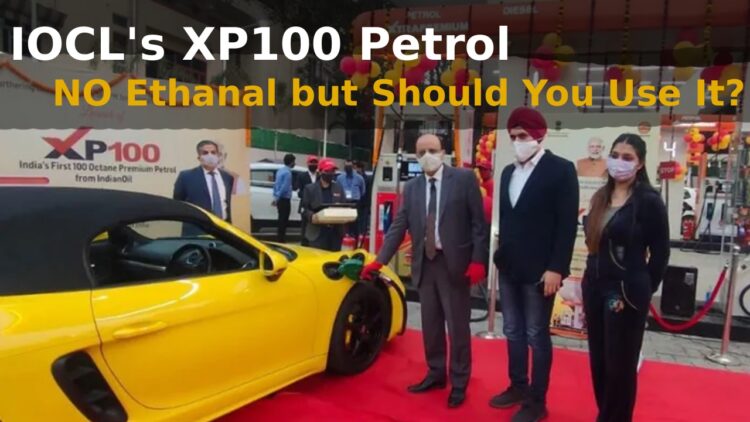Discover if IOCL’s XP100, a premium ethanol-free fuel, is right for your car or bike. Learn its benefits, drawbacks, and ideal usage
In India, the government’s push to adopt 20 % ethanol‑blended petrol (E20) has stirred concern among vehicle owners. The core of the complaint is simple: ethanol has a lower energy density than petrol, so to get the same power output, engines must burn more fuel. As a result, many users report mileage drops of 5–7 %, or sometimes worse, especially in older, non‑E20‑tuned vehicles.
Beyond efficiency, there are compatibility worries. Ethanol is hygroscopic (i.e. it absorbs water), which can lead to corrosion or degradation of fuel lines, seals, injectors, and rubber components in older engines not designed for it. Cold start issues, rough idling, and engine knock are also reported when the fuel system’s materials or calibration aren’t up to the ethanol load. Officially, the government and oil companies argue the impact of ethanol is marginal: for vehicles built to handle E20, the drop in mileage is said to be just 1‑2 %, and higher (3‑6 %) for older ones.
Yet many vehicle owners feel the real‑world effect is larger, especially in two-wheelers and aging cars. So in short: many people feel E20 has hurt fuel efficiency and caused performance or durability issues in non‑compatible vehicles.
Also read: Is Ethanol-blended Fuel Bad For My Car/Bike?
What Makes XP100 Different?
XP100 is IOCL’s premium petrol with 100 octane rating, and critically, effectively zero ethanol. In tests, the ethanol content in XP100 was found to be less than 0.2 %, making it essentially an E0 fuel. Why skip ethanol in this variant? Two practical reasons:
- Low sales volume: 100‑octane fuels are niche, sold in limited quantity. Large‑scale ethanol blending is organized around high‑volume fuels, not these specialty ones.
- Storage stability: Since ethanol attracts moisture, storing E20 over long periods in underground tanks raises the risk of water absorption, phase separation, and degradation. For a slow‑moving product like XP100, ethanol‑free formulation is safer.
In effect, XP100 offers a “pure petrol” option with high octane, which may appeal to performance car or bike owners, those with older vehicles, or anyone wary of ethanol’s downsides.
Should Regular Cars and Bikes Use XP100?
Here’s where things get tricky. For most everyday vehicles, those tuned to run on 95 octane or lower petrol, XP100 is overkill, and in many cases, not worth the extra cost or effort.
Pros of using XP100
- No ethanol risk: For vehicles with vulnerable rubber or plastic fuel components (especially older models), the absence of ethanol reduces corrosion/hygroscopic issues.
- Higher knock resistance: 100 octane gives more margin against pre‑ignition and engine knock, which might benefit tuned or high‑compression engines.
- Cleaner burning additives: Premium fuels often include better detergents, which can improve injector cleanliness and engine health over time.
Cons and caveats
- Wasted octane headroom: A regular car designed for 91-95 RON won’t fully exploit 100 RON; the engine’s timing and mapping don’t change just because you give it richer fuel. You likely won’t see proportional gains in power or efficiency.
- High price premium: XP100 costs substantially more than regular petrol. If the mileage gain (if any) doesn’t offset the cost, you’re burning money.
- Calibration mismatch: Some engines are calibrated tightly for specific octane and fuel characteristics. Mismatches might lead to unintended behavior (though in practice, most modern ECUs will adapt).
- Unnecessary for E20‑compatible cars: If your vehicle is already built to handle E20, the “pure petrol” advantage is less compelling.
Also read: Here’s India’s First Toyota Fortuner with Water Methanol Injection System!
Our Final Thoughts
Using XP100 in a car or bike meant for 95 octane and running on E20 is not harmful per se, but it’s unlikely to give commensurate benefits. You may feel smoother throttle response or think the engine is happier without ethanol. But unless you’re pushing your engine close to its limits (e.g. in sporty driving or high compression motors), the efficiency or performance gains will likely be modest.
If you own an older vehicle with uncertain fuel system materials, or you’ve experienced trouble with ethanol blends, XP100 is a safer alternative, provided you can find it and afford it. But for the average commuter car or normal motorcycle, the extra spend may not justify the gains. In summary: XP100 is a fascinating offering – it gives an ethanol‑free, high octane fuel in a market dominated by blends. But for most regular cars and bikes tuned for 95 or lower, it’s more of an insurance policy or enthusiast’s choice than a practical upgrade.


